Many believe comets are rare parts of our solar system, as only a few make headlines or gain mass attention. However, as of 2023, there are a total of 3,881 known comets in the universe — and far more undiscovered. In 2014, astronomers discovered a new comet that became the largest comet in the solar system. The comet has 100,000 times greater mass than most other known comets and is larger than the entire state of Rhode Island.
Comets are much smaller than planets, but on average, they’re still the size of a small town with “tails” that can extend for millions of miles. Keep reading to learn about the universe’s biggest known comet, including its measurements, its discovery, and other famous comets in the solar system.

What Is a Comet?
Dating back 4,600 million years ago, comets developed from rocks, dust, ice, and gasses when the planets first formed. Comets are made up of leftover debris from formations in the solar system. Often called “cosmic snowballs” or even “dirty snowballs,” comets orbit the Sun and, when heated, spew dust and gases. This forms a “tail” that can stretch for millions of miles. Many scientists attribute Earth’s water and organic compounds to comets that might have hit the planet when the Solar System was still forming.
As comets orbit the Sun, they’re often difficult to see from Earth. However, when the Sun lights up a comet’s gases, you can sometimes see it with a telescope and — rarely — the naked eye.

Comets often form “tails” of debris and gases that trail behind them.
©Brian Donovan/Shutterstock.com
Types of Comets
While comets share similarities in terms of appearance, some have different orbit periods and types. Here are four different categories of comets, including:
- Periodic comets (short-period comets): Periodic, or short-period, comets are those with orbital periods of less than 200 years. In other words, they make their complete return in under 200 years. A prime example of a periodic comet is Halley’s Comet, the first known periodic comet in history.
- Non-periodic comets (long-period comets): Non-periodic, or long-period, comets are those with orbital periods of 200 years or more. This means they don’t make a return within 200 years.
- Comets with no meaningful orbit: Comets with no meaningful orbit have parabolic or hyperbolic orbits. In other words, they don’t orbit the Sun and instead will exist in the solar system, passing through once before Sun’s gravity sends them into interstellar space.
- Lost Comets: Lost comets are those that went undetected during their most recent perihelion passages. There are many lost comets in the universe, some of which astronomers are still attempting to track.
Average Size of a Comet
Astronomers typically measure comets by the size of their nucleus (the solid center of the comet). When frozen, comets are often as big as a small town, ranging from a few miles to tens of miles wide.
The average comet has a nucleus the size of 6 miles (10 km) in width. When a comet gets close to the Sun, however, much of the ice on its surface will vaporize and form a coma (or cloud) around the nucleus and a “tail” (as explained above). These comas can extend 50,000 miles (80,000 km), and the tails can be over 600,000 miles (1 million km) long.

There are many well-known, studied comets in the universe — and even more yet to be discovered.
©Triff/Shutterstock.com
What Is the Largest Comet in Our Solar System?
The largest comet in our solar system is C/2014 UN271 (Bernardinelli-Bernstein), which is 120 km (75 miles) in size. Bernardinelli-Bernstein is an Oort cloud comet, meaning it’s located in the “Oort cloud,” which consists of icy planetesimals that surround the Sun. For reference, it is larger than the state of Rhode Island.
Additionally, the comet’s nucleus is about 50 times larger than most other (discovered) comets’ nuclei. In terms of mass, it is estimated to be around 500 trillion tons — 100,000 times greater than that of a normal comet. This astronomical (pun intended) comet is heading toward Earth at 22,000 miles per hour, but it is not expected to get closer than 1 billion miles away from the Sun (which is projected to occur in 2031).
Discovery of the Largest Comet
In archival images from the Dark Energy Survey, astronomers Pedro Bernardinelli and Gary Bernstein discovered Comet Bernardinelli-Bernstein in 2014. This took place at the Cerro Tololo Inter-American Observatory, which is located in Chile. Originally, the comet was observed in 2010, when it was still 3 billion miles from the Sun.
The size of Comet Bernardinelli-Bernstein wasn’t confirmed until January 2022 when the Hubble Space Telescope. Hubble data was able to show and estimate the size of the comet’s icy, solid nucleus. While it’s the largest known comet out there, astronomers believe Bernardinelli-Bernstein is just the tip of the iceberg. There are likely many more large comets where that came from.
Other Well-Known Comets in the Solar System
As stated earlier, there are almost 4,000 discovered comets in the universe. Here are three of the most well-known comets.
Most Famous Comet: 1P/Halley’s Comet
Halley’s Comet has been deemed the most famous of all. This is because it is the first comet astronomers studied that proved comets could make a return.
In 1705, Edmond Halley, an English astronomer, predicted Halley’s comet would make a return by using Isaac Newton’s theories of gravitation and planetary motions. After studying three bright comets that were spotted during the years 1531, 1607, and 1682, Halley found similarities that suggested it was all actually a single comet. He then predicted that the same comet would make its next return in 1758 — which it did. The first known “periodic” comet was then named after Edmond Halley as a tribute to his discovery.
Halley’s Comet is 9.3 miles by 5 miles (15 kilometers by 8 kilometers) in size. It is also one of the darkest objects in the universe, only reflecting 3% of light.
Second Largest Comet: C/2002 VQ94 (LINEAR)
Before astronomers discovered Comet Bernardinelli-Bernstein, comet C/2002 VQ94 was the record-holder for the largest in the solar system. The Lincoln Near-Earth Asteroid Research (LINEAR) project discovered the comet in 2002, and it has an estimated 60-mile nucleus. LINEAR is a long-period comet, meaning it takes over 200 years to orbit the Sun.
First Discovered Comet: C/1680 V1 (Great Comet of 1680)
While it’s not the first comet to ever exist, the Great Comet of 1680 is the first one ever discovered on a telescope. German Astronomer Gottfried Kirch discovered the comet in November of 1680, and it became one of the brightest comets of the 17th century. In fact, many reported that it was even visible throughout the day. The Great Comet of 1680 is also known for its long tail, which was an estimated 30 million miles in length.

It wasn’t until 1680 that the first comet was discovered through a telescope.
©Allexxandar/Shutterstock.com
First Photographed Comet: C/1858 (Donati’s Comet)
Donati’s Comet, also known as the Great Comet of 1858, was the first comet to be photographed. Astrophotography, or the photography of astronomical objects and celestial events, was just catching on in the mid-19th century. During this time, British portrait painter and photographer William Usherwood captured an image of Comet Donati. The comet then became the first ever photographed comet. While there are no copies of the original picture, the night after Usherwood recorded the comet, George Bond at Harvard College attempted to get a photo himself and managed to record “only the nucleus and a little nebulosity.”
Thank you for reading! Have some feedback for us? Contact the AZ Animals editorial team.








